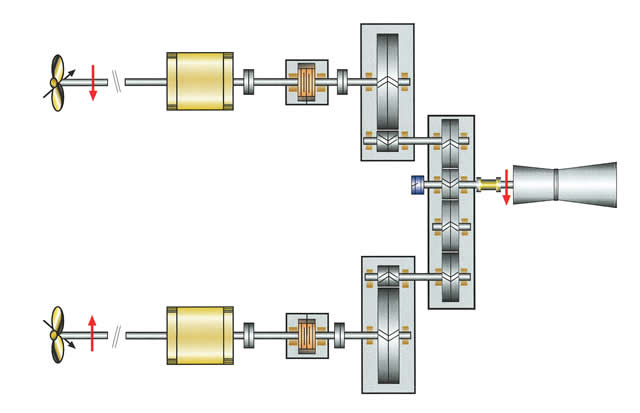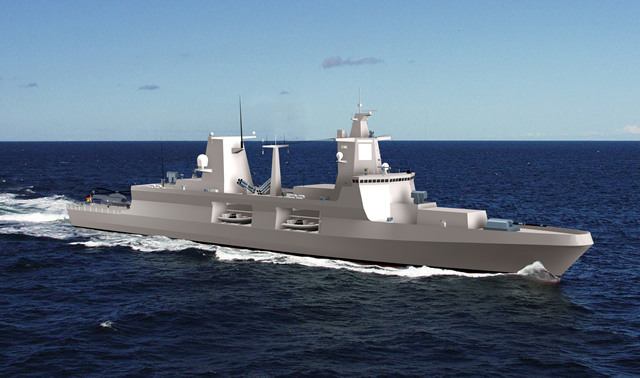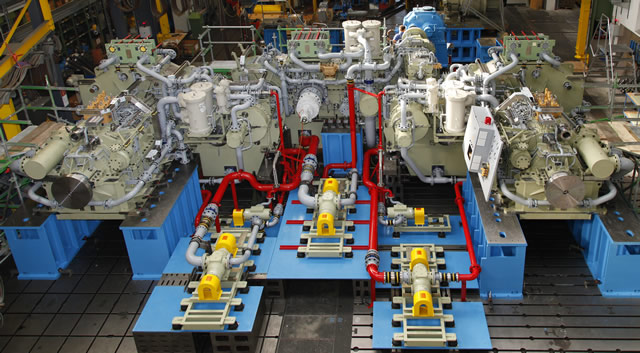|
|
| a |
Euronaval
2012 - Show Daily News |
| |
|
| |
| |
RENK
develops its naval market domain with large Navy orders
|
| |
RENK
AG, Augsburg, is known throughout the world as a supplier of sophisti-cated
gear sets for navy ships. A RENK recipe for success: Professional support
of shipyards and Navies with technical innovations in both the development
and the search for optimization potential, accomplished with continuous
improvement of production tools. |
|
 Fig. 1: Schematic
of the CODELAG propulsion with RENK main gear arrange-ment for Italian
FREMM
Fig. 1: Schematic
of the CODELAG propulsion with RENK main gear arrange-ment for Italian
FREMM
(Picture: RENK)
|
|
As
significant milestone in development of new propulsion concepts for
frigates, the hybrid CODELAG (Combined Diesel Electric And Gas Turbine)
is being considered as state of the art today. With the German Navy
new frigates class F125 and the Italian FREMM frigates, RENK has set
the path by introduction of the referring gear technology successfully.
One center arranged gas turbine and two electric motors provide their
power to both propeller shafts dependent on the mode of operation. The
gas turbine and electric motors are acting as high speed propulsors,
whereas the electric motors are used as long endurance driver for speeds
up to 15 knots. In case of FREMM, the 2 Megawatt motors are sitting
directly on the shaft lines, aft of the gear, s. Fig. 1. The F125 application
pro-vides higher powered 4,5 Megawatt motors arranged forward of the
gear sys-tem, which requires a specifically designed twin clutches on
either side for ap-propriate connection of either the motors or the
gas turbine to the propulsion train, s. Fig. 3.
In continuation of order processing for the US Navy, RENK has currently
eight ship sets for the renowned LCS program under construction. Deliveries
of two gear sets a year are planned to both the Austal and the Lockheed
Martin team each in parallel from 2012 onwards during a period of five
years. The drive con-cepts are significantly different. With the Lockheed
Martin mono-hull, the com-bined power at max. 85 MW of two gas turbines
and two diesel engines is being distributed via two in parallel arranged
CODAG propulsion systems to four water jets. Austal’s trimaran
is also combining four water jets, however, those are be-ing driven
singularly from two gas turbines and two diesel engines, at a total
of 62 MW power. |
|
 Fig. 2: Frigate
type F125 of the German Navy
Fig. 2: Frigate
type F125 of the German Navy
(Picture: RENK)
|
|
Another
highlight in frigate propulsion technique is shown with the re-raised
combination of one center arranged large waterjet with two controllable
pitch propellers, as were equipped three corvettes for the South African
Navy back in 2002. The same constellation came now to realization for
two frigates for the Algerian Navy being built at Blohm+Voss Naval GmbH.
The shipyard relies on the unparalleled expertise of RENK gas turbine
and cross connect diesel engine gears, now in service for ten years
without any quality caused disruption.
Also on the OPV market (offshore patrol vessels), combined propulsion
is the latest art. Here, diesel engines are combined with electric motors
in CODELOD to relieve the diesels from their duty to be operated in
partial power at loiter or cruise speeds. Small electric motors are
much better suitable to cover that speed range. For conventionally sized
OPVs a maximum of 500 Kilowatt power per shaft is required to drive
the vessel up to 14 knots speed. RENK CODELOD gears are introduced with
a number of applications, such like the Holland class OPVs, the Korean
Coast Guard large 3000 ton cutters, or the Omani OPVs “Khareef”,
s. Fig. 4. For the successor program “Al Ofouq”, including
four advanced OPVs, RENK was awarded an order for again CODELOD gears
trans-mitting 9,1 Megawatt diesel power and 300 Kilowatt motor power
per shaft |
|
 Fig. 3: The
F125 RENK CODELAG gear system with cross connect gear (center) and port
and starboard main gears, view from forward. Clutch arrangements in
front of main gears.
Fig. 3: The
F125 RENK CODELAG gear system with cross connect gear (center) and port
and starboard main gears, view from forward. Clutch arrangements in
front of main gears.
(Picture: RENK)
|
|
Finally,
a highly recognized award completes the RENK order book as per end of
this summer, addressing the propulsion system for the new generation
fleet tankers for the British Navy. Again, it was decided for a most
advanced CODELOD system for those four 25 000 tons vessels, this time
based on medi-um speed diesel engines. The specific propulsion arrangement
and high reduc-tion gear ration resulted in a so called “nested
gear” design, where the first re-duction gear wheels “embrace
“ the second reduction pinions. Opposite of the main diesel engines,
electric motors act as propulsor (PTI) for cruise speed, or as generator
(PTO) used as additional electric source for onboard power supply, where
internal of the RENK main propulsion gear the power trains are being
organized by automatically shifted multi disc clutches. Together with
an intelli-gent power distribution system, this kind of a propulsion
system is considered as highly efficient – RENK gears enable a
new step towards further advanced pro-pulsion technology. |
|
 Renk stand
at Euronaval 2012
Renk stand
at Euronaval 2012
|
|
Together
with their experience in individual drive train solutions aboard fleets
of 40 Navies worldwide, RENK’s role as leading gear supplier in
this sophisticated field of application has been significantly increased.
A number of projects show the preference of customers to receiving RENK’s
advice regarding propulsion system optimization in early phases of ship
developments when the entire con-figuration needs to be defined depending
on the vessel’s mission profile.
Visit Renk at Euronaval on booth G30 |